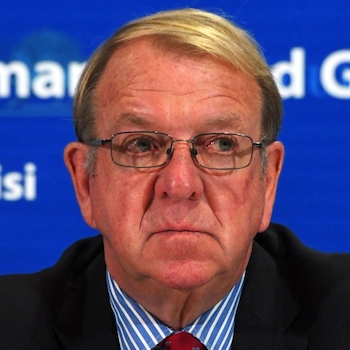Why the Iranian Protests this Time are Different
The mass uprising that has continued for weeks in the central Iranian city of Isfahan, has now sparked spontaneous protests in towns and cities across Iran. Tens of thousands of impoverished farmers who took to the streets in Isfahan, to protest water shortages, were met with tear gas, baton charges, and shotgun assaults by the Islamic Revolutionary Guards Corps (IRGC).
More than 600 farmers have been arrested, while around 300 were wounded by shotgun blasts. Several were shot in the face, in many cases losing sight in one or both eyes. In the nationwide protests that have followed, hundreds of demonstrators are now wearing symbolic eye patches covering one eye, in sympathy with their wounded compatriots. Farmers in Ramshir, in Khuzestan Province, also held a rally in protest of the government’s refusal to open dams and give them access to water essential for their seasonal crops. Like their colleagues in Isfahan, the farmers blame the IRGC, who controls Iran’s economy, for diverting key watercourses and rivers to supply military factories from which they corruptly pocket the profits.
The mass protests by Isfahan’s starving farmers have been joined by a nationwide uprising of Iranian teachers. Demonstrations have taken place in almost every province, covering at least 66 cities, including Tehran, Isfahan, Kermanshah, Khuzestan, Yazd, Fars, Qazvin, Mazandaran, Khorasan, Kerman, and Sistan and Baluchestan. The teachers are outraged that they are now struggling to survive on salaries that are below the international poverty line, while the regime continues to finance the development of nuclear weapons and ballistic missiles and funds Syria’s Bashar al-Assad, the Houthi rebels in Yemen, Hezbollah in Lebanon, the Shi’ia militias in Iraq and Hamas in Gaza. The teachers in Tehran and Alborz Provinces gathered in front of the Majlis (parliament).
In other cities, the rallies took place in front of the offices of the education ministry, with teachers chanting slogans like: “Teachers would die but won’t submit,” and “Detained teachers must be released,” and “This nation has never seen such injustice.”
The teachers’ uprising has also been joined by workers from a mineral company in Khuzestan Province. They rallied in front of the mining company’s offices for three consecutive days last week. Their protest was mirrored by angry workers from copper mines in Songoon, in Iran’s north-western province of East Azarbaijan, who demonstrated outside the mining company’s offices, and the offices of several other mining and road construction companies. The protesters were outraged at the dismissal of dozens of their co-workers, as well as discrimination in the workplace, ambiguous contracts, and the regime’s refusal to implement laws that would boost their salaries.
The striking workers’ sense of outrage has been fuelled by an interview on Iranian television, where Mohammad Bagher Ghalibaf, the speaker of Iran’s parliament, admitted that the regime is draining money from the pockets of people to try to balance Iran’s massive budget deficit. “When we have a budget deficit, we have to admit that we are putting our hands in the people’s pockets. We are earning the current government’s budget and expenses from poor people. People sense this in their daily lives,” Ghalibaf said.
Now in the latest mass protest, customers of the regime-linked car maker, Azarbaijan Sanat Khodro (Azvico), joined a large demonstration last week. More than 6,000 Iranians had paid in advance for cars from Azvico’s MG360 range, only to be informed by the company that their vehicles will not be delivered due to a lack of parts and failing financial resources. Despite having pre-sold 6,400 vehicles more than a year ago, Azvico has still not delivered a car and has informed its customers that they cannot revoke their purchases or demand their money back.
With 75% of Iranians now struggling to survive on daily incomes below the international poverty line, protests against the regime have grown in size and ferocity. On top of the water crisis, the people are now suffering from high unemployment, rampaging inflation, spiraling prices, disintegrating living conditions, and a collapsing economy. All of this is taking place against the background of the COVID pandemic, which has spread out of control across the country, with hundreds of thousands dead from the disease.
The escalating nationwide protests and the intensifying violent repression by the regime have created a boiling volcano, ready to erupt. Supreme Leader Ayatollah Ali Khamenei has appointed Ebrahim Raisi as his president. Raisi is notorious for his central role in the 1988 massacre of more than 30,000 political prisoners and the killing by IRGC security forces of 1,500 mostly young protesters, during the November 2019 nationwide uprising. Raisi’s criminal involvement in genocide and crimes against humanity is now under close scrutiny by the United Nations and international human rights organizations including Amnesty International and Human Rights Watch. A dossier of evidence against Raisi has been handed to the Metropolitan Police in London.
The resumption of negotiations on the defunct Joint Comprehensive Plan of Action (JCPOA) nuclear deal in Vienna has left the beleaguered Iranian people scratching their heads in disbelief. They wonder how it is possible for the Biden administration to renew talks with a regime that is starving its people, escalating human rights abuses, financing proxy-wars across the Middle East, and accelerating its bid to build a nuclear bomb. The deeply flawed JCPOA was signed by Obama in 2015 and scrapped by Trump in 2018. The deal was only ever designed to last for 10 years, of which only 4 remain. Meeting Tehran’s demands for the lifting of all sanctions and for full compensation for the economic damage they allege to have been caused by Trump’s ‘maximum pressure’ campaign, would throw a lifeline to this regime, and represent a naked act of betrayal of the Iranian people. President Biden should withdraw from the Vienna talks now.

